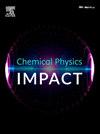紫檀花纳米硒的绿色合成及详细表征
IF 4.3
Q2 CHEMISTRY, PHYSICAL
引用次数: 0
摘要
近年来,环境可持续合成硒纳米粒子(Se NPs)因其在医学、电子和环境修复方面的潜在应用而引起了人们的极大兴趣。本文研究了以丹参叶和果实提取物为原料,生态合成硒纳米粒子的方法,重点研究了提取方法的优化,以提高促进硒离子还原成纳米粒子的植物化学物质的产量。利用复杂的分析技术对合成的Se NPs进行了表征,以阐明其结构,形态和组成属性。紫外可见光谱通过表面等离子体共振峰验证了硒纳米粒子的有效合成。FTIR研究阐明了提取物中的官能团及其在还原过程中与硒的相互作用。XRD分析证实了所制备的纳米颗粒的晶体结构,其峰与不同的硒相排列,从而验证了它们的有效合成。FESEM与EDS集成提供了详细的形态洞察和元素组成分析,展示了纳米颗粒之间的均匀分布和尺寸一致性。元素映射进一步证实了合成结构中硒的存在。此外,HR-TEM结合SAED提供了对Se NPs结晶度和尺寸分布的原子水平见解,揭示了它们在各种应用中的潜力。合成的纳米颗粒具有良好的稳定性和生物相容性,具有良好的生物医学应用前景。本研究不仅强调了硒纳米粒子的有效绿色合成途径,而且强调了利用自然资源在纳米材料生产中的重要性。这些发现为纳米技术提供了一种可持续的纳米粒子合成方法,同时为未来研究纳米粒子在不同领域的功能应用铺平了道路,从而对纳米技术做出了重大贡献。本文章由计算机程序翻译,如有差异,请以英文原文为准。

Green synthesis and detailed characterization of selenium nanoparticles derived from Alangium salviifolium (L.f) Wangerin
In recent years, the environmentally sustainable synthesis of selenium nanoparticles (Se NPs) has garnered significant interest owing to its prospective applications in medicine, electronics, and environmental remediation. This work investigates the eco-friendly synthesis of Se NPs using extracts from Alangium salviifolium leaves and fruits, emphasizing the optimization of the extraction method to increase the output of phytochemicals that promote the reduction of selenium ions into nanoparticles. The characterization of the synthesized Se NPs was conducted utilizing sophisticated analytical techniques to clarify their structural, morphological, and compositional attributes. UV–Vis spectroscopy validated the effective synthesis of Se NPs via a characteristic surface plasmon resonance peak. The FTIR study elucidated the functional groups in the extracts and their interactions with selenium throughout the reduction process. XRD analysis demonstrated the crystalline structure of the produced nanoparticles, with peaks aligned to distinct selenium phases, so validating their effective synthesis. FESEM integrated with EDS offered detailed morphological insights and elemental composition analysis, demonstrating uniform distribution and size consistency among the nanoparticals. Elemental mapping further corroborated the presence of selenium within the synthesized structures. Additionally, HR-TEM combined with SAED provided atomic-level insights into the crystallinity and size distribution of Se NPs, revealing their potential for various applications. The synthesized nanoparticles exhibited remarkable stability and biocompatibility, suggesting promising prospects for biomedical applications. This study not only highlights an effective green synthesis route for Se NPs but also underscores the importance of utilizing natural resources in nanomaterial production. The findings contribute significantly to nanotechnology by providing a sustainable approach to nanoparticle synthesis while paving the way for future research into their functional applications across diverse sectors.
求助全文
通过发布文献求助,成功后即可免费获取论文全文。
去求助
来源期刊

Chemical Physics Impact
Materials Science-Materials Science (miscellaneous)
CiteScore
2.60
自引率
0.00%
发文量
65
审稿时长
46 days
 求助内容:
求助内容: 应助结果提醒方式:
应助结果提醒方式:


